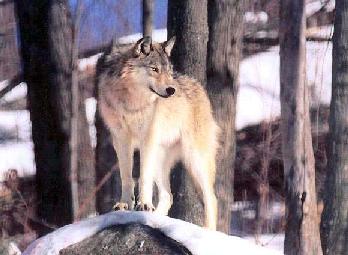Life in the Pack
Wolves are social animals.
This means that like humans, they live in family groups.
Instead of calling this group a family, though, groups of
wolves
are called packs.
There
are usually about 8 to 12 wolves in a pack. Below you'll
learn
about why it's so important for wolves to live in packs, and what
members make up a pack.
Strength in Numbers
Members of the Pack
Lone Wolves
Strength
in Numbers
Working together is vital for the survival of the pack. The
members of the pack help to protect each other. Having
several
wolves together also makes it easier to hunt. Wolves
use teamwork to take down their prey. This way they can kill
animals that are larger than them, such as moose and caribou.
It
also enables them to surround their prey.
Members
of the Pack
Alpha Pair
Yearlings
Pups
Other Subordinates
Alpha Pair
The dominant
wolves in the pack
are called the alpha male and alpha female. Usually, these
are
the only two wolves in the pack that breed. Like parents in a
human family, they make important decisions about the daily activities
of the pack. They also lead the group on hunting trips.
Yearlings
These wolves are the pups from the year before, and they are still
learning to be good hunters. They are subordinate,
meaning they show respect to the alpha pair and accept them as their
leaders. They also help take care of the new pups -- just
like
human brothers and sisters help out their parents by babysitting
younger siblings.
Pups

These new members of the pack are born to the alpha female in the
spring, in a den
she finds or digs for herself. After about 4 weeks of living
on
their mother's milk, they can eat meat. They lick and nuzzle
adult wolves' mouths to get them to cough up (or regurgitate) meat
that they have recently eaten. Adult wolves also care for
them at special meeting places, called rendevous sites,
where the pups stay until they are old enough to travel with the pack.
Other
Subordinates
The rest of the pack is usually made up of the alpha male's brothers
and sisters. Sometimes they let other wolves join them.
Lone Wolves

Occasionally a wolf will disperse,
or leave the pack. This wolf will usually seek its own mate
and
try to form a pack of its own. It's hard for wolves to make
it on
their own, though, so lone wolves don't always survive long enough to
do this.



